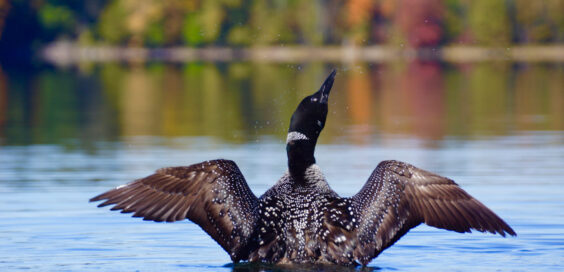
Creature Feature – Goin’ Loony this Fall
Posted by Dustin Horton // October 26, 2024 // Articles, Creature Feature
While we don’t see a lot of common loons hanging around our region over the summer, chances to observe them are better in fall when these beautiful icons of the north are migrating to the Atlantic Ocean, where they’ll spend the winter. As they travel southward, loons may stopover on our area lakes and ponds to rest and recharge.
According to the Loon Preservation Committee, the timing of fall migration can vary between individuals. Adults that remained “single” or had failed nests this past breeding season might leave the lakes for the ocean as early as late summer, since they don’t have chicks to care for. Meanwhile, pairs that raised chicks may remain on their lakes into October. Loon pairs usually migrate separately and won’t spend the winter together. Typically, one parent leaves for migration first; the remaining parent hangs around for another week or two, but eventually leaves their chick(s) behind. The good news is that by this time, youngsters are ready to fend for themselves, including catching their own food.
While scientists aren’t sure how they do it, juvenile common loons are able to navigate their maiden journey in the fall. Incredible! It is crucial, however, that they leave their natal lake before it ices over, or else they can get stranded. Sometimes, young loons will congregate on lakes in social groups as they prepare to migrate to their wintering grounds. Juvenile loonies can be identified from adult birds by their scalloped plumage pattern and brown eyes.
Article & photo by Margie Manthey













